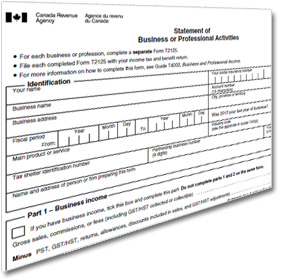Self-Employed and Contract Earnings: How-To File Your Personal Tax Return
By Julie King | February 1, 2013
 Did you earn income outside of your regular day job in 2012 that won't be reported on the T4 from your employer? This article will help you understand how to declare your contract and/or self-employment income on your 2012 tax return.
Did you earn income outside of your regular day job in 2012 that won't be reported on the T4 from your employer? This article will help you understand how to declare your contract and/or self-employment income on your 2012 tax return.
To get started there are essentially two question you need to ask. Did you earn in income outside your job last year? If so, would the Canada Revenue Agency (CRA) view the income you generated as legitimate business income?
The second question is important, because it prevents Canadians from essentially writing off their hobbies. As nice as it would be to spend more than we make on our hobbies and then report the net loss to effectively reduce our taxable income, that is not something CRA allows.
What are your expectations of making a profit?
"For income tax purposes, a business is an activity that you intend to carry on for profit and there is evidence to support that intention," the CRA explains on its website.
So assuming you have earned income that will need to be reported on your personal income tax return, what do you do next?
CRA requires anyone in Canada who earns business income to keep proper records. That means you will need to have records showing both what you earned as well as any valid expenses or purchases. By subtracting expenses from your gross income for a particular financial year you can calculate your net profit or loss. Your self-employed or contract income must be reported on a calendar year basis.
The process that you will follow is not overly difficult. You will use Statement of Business or Professional Activities (Form T2125) to total your income, expenses and net profit (or loss) for tax purposes.
Note that not all expenses are treated the same
When entering your expenses, it is important to know that not all purchases are treated the same.
Some things that you buy to help you operate your business, like furniture or computers, are considered assets for the business and you do not write-off the full amount in the year of purchase. Instead, these are treated as 'capital expenditures' and you need to use the capital cost allowance (CCA) formula set-out by CRA to calculate how much depreciation expense you can claim.
Also, some of your 'current' expenses cannot be deducted in full or may have special rules. For example, you can only deduct 50% of your meals and entertainment expenses. Our article, A Guide to Expense Deductions in your Business provides a good overview of the exceptions.
Calculate and record your net profit (or loss)
Once you have calculated your net profit (or loss), lines 135-143 on your personal tax return is where you enter your self-employment earnings. Be sure to read our article, Filing Your Business Income Tax Return: A 7 Step Guide for Self-Employed Canadians Sole Proprietors and Partnerships, for more information on the step-by-step process.
And remember, you earned extra money because someone valued your expertise. If this seems complicated to you, it may be better to hire an expert to help you prepare your tax return.
An accountant professional who specializes in tax can help you understand subtle points when preparing your tax return and can often help you find savings you might not have realized yourself. Sometimes you need to spend money in order to save.






